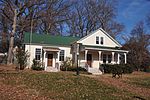John Gunnell House
1852 establishments in VirginiaFairfax County, Virginia geography stubsGreek Revival houses in VirginiaHouses completed in 1852Houses in Fairfax County, Virginia ... and 3 more
Houses on the National Register of Historic Places in VirginiaNational Register of Historic Places in Fairfax County, VirginiaNorthern Virginia Registered Historic Place stubs

John Gunnell House, also known as the George Coleman House, is a historic home near Great Falls, Fairfax County, Virginia. It was built in 1852, and is a two-story, five bay, "T"-shaped frame dwelling in a vernacular Greek Revival style. It has an English basement, attic, and intersecting gable roofs with brick chimneys at each of the three gable ends. Also on the property is a contributing outbuilding, now used as a tool shed.It was listed on the National Register of Historic Places in 2006.
Excerpt from the Wikipedia article John Gunnell House (License: CC BY-SA 3.0, Authors, Images).John Gunnell House
Walker Woods Drive,
Geographical coordinates (GPS) Address Nearby Places Show on map
Geographical coordinates (GPS)
| Latitude | Longitude |
|---|---|
| N 39.015277777778 ° | E -77.289722222222 ° |
Address
Riverbend Golf Course
Walker Woods Drive
22066
Virginia, United States
Open on Google Maps









